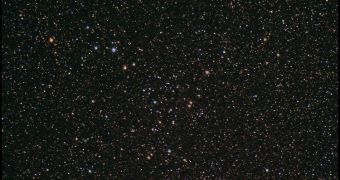A star grouping first discovered more than 180 years ago, but never really investigated in detail by astronomers, may hold the key towards making it easier for us to detect extrasolar planets. The cosmic formation is called NGC 6774, or Ruprecht 147.
What is interesting about this particular structure is that the stars it contains are not bound together tightly – as similar objects inside clusters are – but rather they interact with each other via gravity only loosely, enough for the formation to maintain some degree of integrity.
By studying it, astronomers hope to be able to gain a deeper understanding of how Sun-like stars appear and develop. Since the main goal of exoplanetary research today is to find Earth-like stars, the natural stellar candidates to host these worlds are those similar to our own star.
In other words, experts are interested in finding out how G-type yellow dwarfs appear and develop. NGC 6774 is especially well suited to help in this regard, considering its physical properties, and the fact that it contains large numbers of such stars.
Details of a new investigation of the stellar association, conducted by a team from the Pennsylvania State University (Penn State), appear in a paper that has been submitted for publication in the renowned Astronomical Journal, and will appear in a future issue of the magazine.
“We have discovered that a previously unappreciated open star cluster, which is a little younger than our Sun, holds great promise for use as a standard gauge in fundamental stellar astrophysics,” says Penn State assistant professor of astronomy and astrophysics, Jason T. Wright.
He is the one who conceived and initiated the new research, and will present the study later this month, at the 17th Cambridge Workshop on Cool Stars, Stellar Systems, and the Sun, to be held in Barcelona, Spain, Astrobiology Magazine reports.
“The cluster was rediscovered in the 1960s by Jaroslav Ruprecht, which is how it got its current name, but until now no astronomers paid it any special attention, probably because many presumed it was an asterism – a chance alignment of unrelated stars,” the scientist explains.
The study was conducted using the wide-field cameras on the MMT telescope, in Arizona, and the Canada-France-Hawaii Telescope, on Mauna Kea, in Hawaii. Even so, due to the vast area that the cluster covers, researchers had to snap multiple pictures, and then combine them in larger mosaics.
Ruprecht 147 was found to contain stars that are, on average, 2.5 billion years old, or about half the age of the Sun. They are about the same age that our star was when the first multicellular lifeforms are believed to have appeared here on Earth.
“Our project with this important cluster is just beginning. Eventually, it is going to let us find and study nearby stars with a mass like the Sun's, to help in the hunt for Earth-like planets, and to test and improve the models astronomers use to understand the evolution of stars including our own Sun,” Wright concludes.

 14 DAY TRIAL //
14 DAY TRIAL //